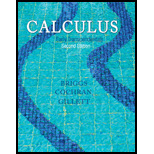
Explain why or why not Determine whether the following statements are true and give an explanation or counterexample.
a. Assuming g is integrable and a, b, c. and d are constants,
b.
c. Changing the order of
d. The transformation T: x = v, y –u maps a square in the uv-plane into a triangle in the xy-plane.
a.
Answer to Problem 1RE
The statement is not true.
Explanation of Solution
Given:
The integrable function g and the constants a,b,c,d.
Theorem used:
Fubini’s Theorem: Let f be continuous on the rectangular region
The double integral of f over R may be evaluated by either of two iterated integrals:
Reason:
Use the above mentioned Fubini’s theorem to prove this statement.
When we write
Consider the example the volume of a solid bounded by the surface
On further simplification,
Implify the Right hand side of the give equation,
On further simplification
From the equations (1) and (2), we can find that the evaluated values are not the same.
Hence, the statement is not true.
b.
Answer to Problem 1RE
The statement is true.
Explanation of Solution
Given:
Reason:
The set
Thereby the set is same as the remaining two sets
Hence, the statement is true.
c.
To find: Whether the change of order of integration in
Answer to Problem 1RE
The statement is not true.
Explanation of Solution
Given:
The integral
Theorem used:
Let f be continuous over the region
where g,h,G and H are continuous functions. Then f is integrable over D and the triple integral is evaluated as the iterated integral
Reason:
Consider the example,
Use the above theorem to change the order of integration in the above example,
It is observed that the change in order of integration does not alter the integrand.
Hence, the statement is not true.
d.
Answer to Problem 1RE
The statement is not true.
Explanation of Solution
Given:
The transformations are
Reason:
Take the image of S in the uv- plane is
The uv- plane bounded by the vertices
From
Substitute
Therefore, xy- plane traces out the segment from
From
Substitute
Therefore, xy- plane traces out the segment from
From
Substitute
Therefore, xy- plane traces out the segment from
From
Substitute
Therefore, xy- plane traces out the segment from
Thus, the image of region in xy- plane is a square with vertices
Hence, it does not maps into a triangle and thereby the statement is not true.
Want to see more full solutions like this?
Chapter 13 Solutions
Calculus: Early Transcendentals (2nd Edition)
- Calculus III May I please have some elaborations on Example 2 part a? Thank you.arrow_forward1. A bicyclist is riding their bike along the Chicago Lakefront Trail. The velocity (in feet per second) of the bicyclist is recorded below. Use (a) Simpson's Rule, and (b) the Trapezoidal Rule to estimate the total distance the bicyclist traveled during the 8-second period. t 0 2 4 6 8 V 10 15 12 10 16 2. Find the midpoint rule approximation for (a) n = 4 +5 x²dx using n subintervals. 1° 2 (b) n = 8 36 32 28 36 32 28 24 24 20 20 16 16 12 8- 4 1 2 3 4 5 6 12 8 4 1 2 3 4 5 6arrow_forward= 5 37 A 4 8 0.5 06 9arrow_forward
- Consider the following system of equations, Ax=b : x+2y+3z - w = 2 2x4z2w = 3 -x+6y+17z7w = 0 -9x-2y+13z7w = -14 a. Find the solution to the system. Write it as a parametric equation. You can use a computer to do the row reduction. b. What is a geometric description of the solution? Explain how you know. c. Write the solution in vector form? d. What is the solution to the homogeneous system, Ax=0?arrow_forward2. Find a matrix A with the following qualities a. A is 3 x 3. b. The matrix A is not lower triangular and is not upper triangular. c. At least one value in each row is not a 1, 2,-1, -2, or 0 d. A is invertible.arrow_forwardFind the exact area inside r=2sin(2\theta ) and outside r=\sqrt(3)arrow_forward
- A 20 foot ladder rests on level ground; its head (top) is against a vertical wall. The bottom of the ladder begins by being 12 feet from the wall but begins moving away at the rate of 0.1 feet per second. At what rate is the top of the ladder slipping down the wall? You may use a calculator.arrow_forwardExplain the focus and reasons for establishment of 12.4.1(root test) and 12.4.2(ratio test)arrow_forwarduse Integration by Parts to derive 12.6.1arrow_forward
- Explain the relationship between 12.3.6, (case A of 12.3.6) and 12.3.7arrow_forwardExplain the key points and reasons for the establishment of 12.3.2(integral Test)arrow_forwardUse 12.4.2 to determine whether the infinite series on the right side of equation 12.6.5, 12.6.6 and 12.6.7 converges for every real number x.arrow_forward
 Holt Mcdougal Larson Pre-algebra: Student Edition...AlgebraISBN:9780547587776Author:HOLT MCDOUGALPublisher:HOLT MCDOUGALAlgebra & Trigonometry with Analytic GeometryAlgebraISBN:9781133382119Author:SwokowskiPublisher:Cengage
Holt Mcdougal Larson Pre-algebra: Student Edition...AlgebraISBN:9780547587776Author:HOLT MCDOUGALPublisher:HOLT MCDOUGALAlgebra & Trigonometry with Analytic GeometryAlgebraISBN:9781133382119Author:SwokowskiPublisher:Cengage Elements Of Modern AlgebraAlgebraISBN:9781285463230Author:Gilbert, Linda, JimmiePublisher:Cengage Learning,
Elements Of Modern AlgebraAlgebraISBN:9781285463230Author:Gilbert, Linda, JimmiePublisher:Cengage Learning, Linear Algebra: A Modern IntroductionAlgebraISBN:9781285463247Author:David PoolePublisher:Cengage Learning
Linear Algebra: A Modern IntroductionAlgebraISBN:9781285463247Author:David PoolePublisher:Cengage Learning Elementary Linear Algebra (MindTap Course List)AlgebraISBN:9781305658004Author:Ron LarsonPublisher:Cengage Learning
Elementary Linear Algebra (MindTap Course List)AlgebraISBN:9781305658004Author:Ron LarsonPublisher:Cengage Learning Glencoe Algebra 1, Student Edition, 9780079039897...AlgebraISBN:9780079039897Author:CarterPublisher:McGraw Hill
Glencoe Algebra 1, Student Edition, 9780079039897...AlgebraISBN:9780079039897Author:CarterPublisher:McGraw Hill





